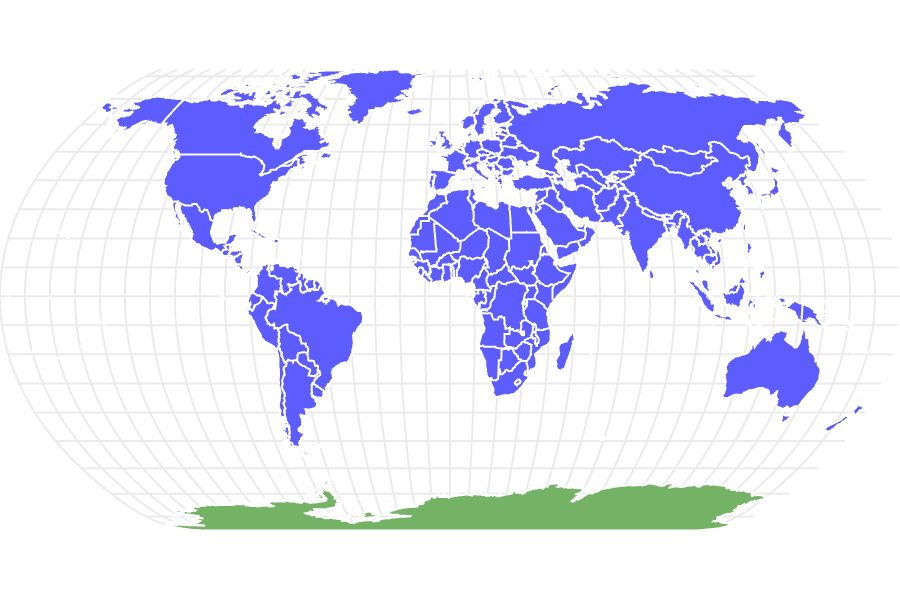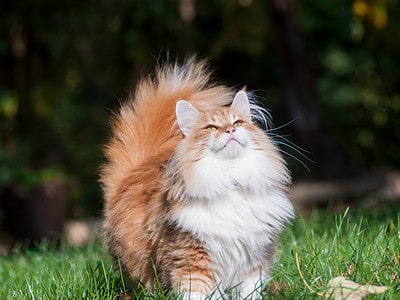Orb Weaver
Females are about four times the size of males
Advertisement
Orb Weaver Scientific Classification
Orb Weaver Facts
- Prey
- mosquitoes, gnats, flies, aphids, moths, grasshoppers
- Fun Fact
- Females are about four times the size of males
- Biggest Threat
- birds
- Most Distinctive Feature
- Skull-like head
- Other Name(s)
- Orb spider, garden spider
- Gestation Period
- 3-6 months
Orb Weaver Physical Characteristics
- Color
- Brown
- Yellow
- Black
- White
- Golden
- Skin Type
- Exoskeleton
- Lifespan
- 12 months
- Length
- 0.25-0.375 inch (male); 1-1.5 inches (female)
- Age of Sexual Maturity
- 6-9 months
View all of the Orb Weaver images!
The Orb Weaver is a spider commonly found outside homes, in hedges, tall grasses, and trees.
They are a helpful predator who feeds off the pest bugs we don’t like, such as mosquitoes, beetles and other bothersome flying insects. They build elaborate, circular webs and are most often seen in late summer and early fall. They are neither poisonous nor venomous.
5 Incredible Orb Weaver Facts!
- There are over 3000 species of Orb Weavers worldwide.
- Females are significantly larger than males.
- Several species cannibalize the males after mating.
- They are docile and non-aggressive, and bites are very rare.
- They get their name because orb means round and their webs are large and circular, in most cases, though they make adaptations to their circular webs as they mature.
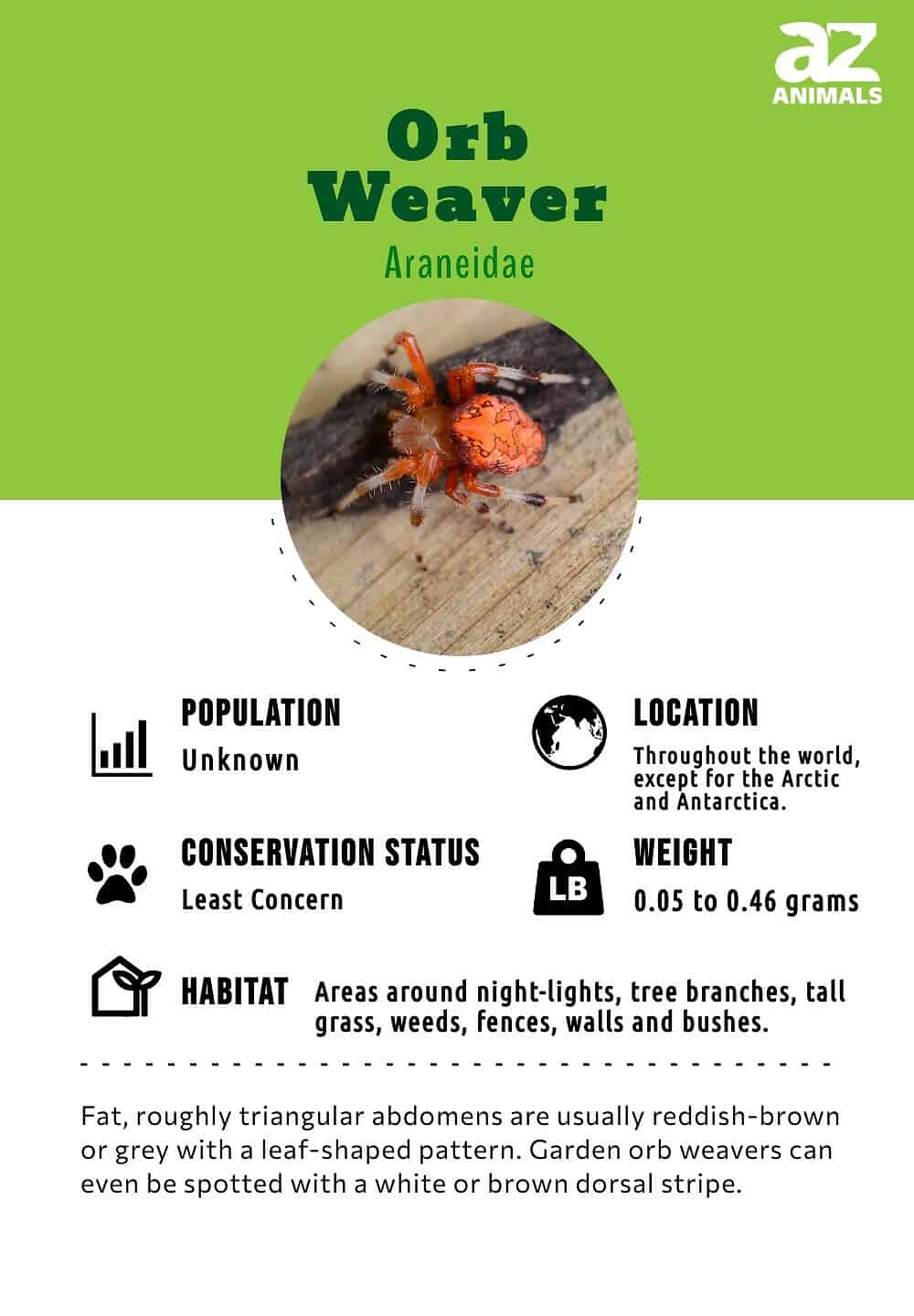
Species And Scientific Name
More than 3000 species of Orb Weaver exist all across the world, spread across nearly 200 genera. The common scientific name for the orb weaver is Araneidae.
Evolution And Origin
The spider presumably evolved from an arachnid ancestor, around 400 million years ago, during the early Paleozoic era. This ancestor was a thick-waisted insect and most likely newly emerged from a life spent in the water. Many of the early spider fossils show that primitive spiders, known as Mesothelae, were ground-dwelling spiders since their spinnerets were located under the middle of their abdomen, as opposed to the spiders of today that have this on their end of the abdomen.
The spinneret being located at the rear abdomen didn’t appear on spiders until 250 million years ago, at the end of the Paleozoic era. This is what helped them to develop their sophisticated aerial webs which enable them to catch flying insects. The spider animal group of today was found to be similar to those that were existing over 30 million years ago.
Types Of
The orb weaver spider belongs to a family that has over 3000 species.
- Yellow Garden Spider (Argiope aurantia)
- Banded Garden Spider (Argiope trifasciata)
- Cross Orbweaver (Araneus diadematus)
- Marbled Orbweaver (Araneus marmoreus)
- Shamrock Orbweaver (Araneus trifolium)
- Giant Lichen Orbweaver (Araneus bicentenarius)
- Cat-faced Orbweaver (Araneus gemmoides)
Appearance

A close-up shot of a colorful Orb Weaver spider.
©Chui Wui Jing/Shutterstock.com
Since there are so many species with so many body adaptations and variations in appearance, it would be impossible to detail them all here. Some are brightly colored or even golden and have adaptations like spiny bodies. Others have smooth bodies that are not spiny at all. The males tend to be drab and brown. The females tend to be quite large for non-venomous spiders, and their heads are much smaller than their bellies, but one species may look nothing like another, aside from their large round web.
However, identification of the most common female garden spider or Orb Weaver in the United States is very easy. They create large, intricate webs, often creating a zigzag pattern behind which they hide during the daylight hours. She is primarily yellow or golden, white, and black with a stripe and dotted pattern on the front of her abdomen and an almost zebra-like pattern on the back with a yellow box in the middle. The front of the head is grayish-white with a pattern resembling a skull and a yellow stripe down the middle of the head on the backside.
Her abdomen is much larger than her head. Her body is about one inch to an inch and a half long. With her abdomen in the air, she resembles a skull wearing a Pope hat. Her leg span is typically between two to three inches across and makes an almost X shape when in repose. Her abdomen is large, and the top portion is somewhat flat rather than rounded, while the bottom is significantly tapered with a rounded end.
The male Orb Weaver looks much different than the female. He will typically be just under half an inch long in the body, with legs that only extend about half an inch across and much closer to his body. He is usually a drab brown or gray with a stubbier, pointier abdomen, though it will still be flat across the middle. His web will be similarly intricate, but generally much smaller and it will lack the zigzag of the female web. They like to build their webs in eaves and across the top of doorways.
Habitat
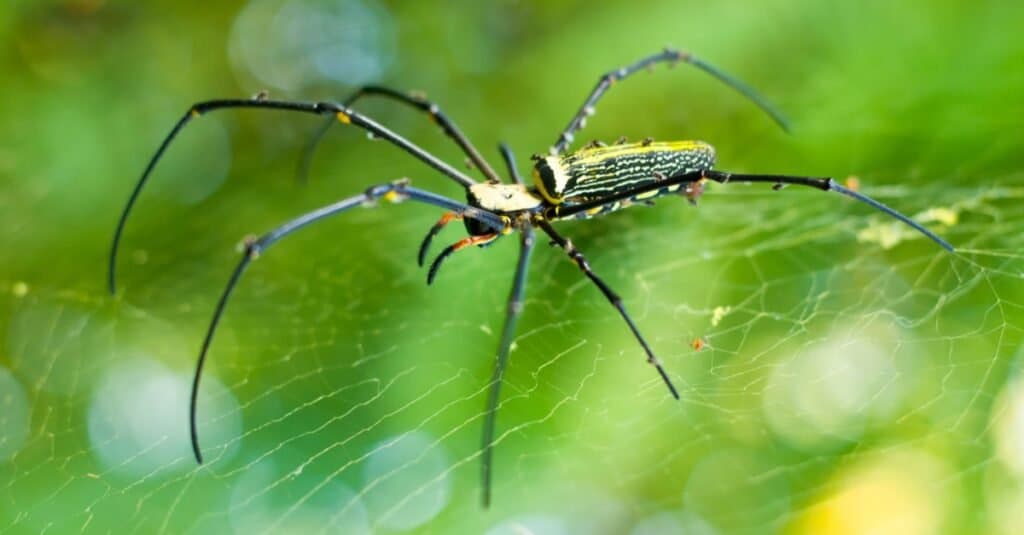
s prefer to be above the ground, often weaving webs around four feet in the air.
©makuromi/Shutterstock.com
When an Orb Weaver builds a web on a home property, they typically like to stretch their webs in between two things, such as between hedges, from walls to hedges, or between two sides of a corner. In their natural habitat, they will form webs between tree branches or tall blades of grass. They prefer to be above the ground, often making webs around four feet in the air, but sometimes they will make webs within a foot or two of the ground, depending on where the prey is.
Diet
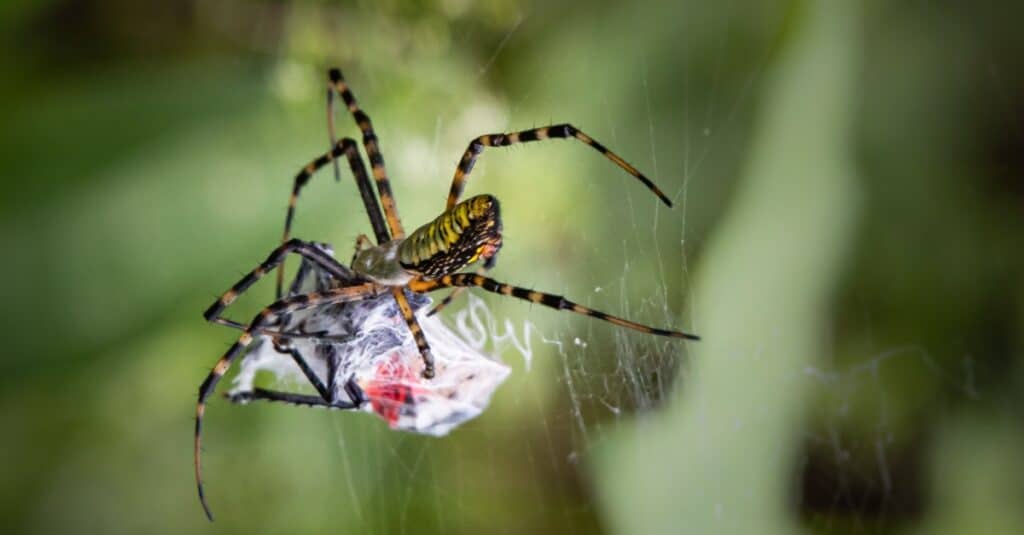
This Garden Spider wraps a Spotted Lanternfly to save for her next meal.
©cwieders/Shutterstock.com
Orb Weavers are very beneficial spiders, as they eat a lot of the insects that we consider pests, such as mosquitoes, gnats, and flies. They also like beetles, and some species will eat hummingbirds if they become trapped in the nest.
Prevention
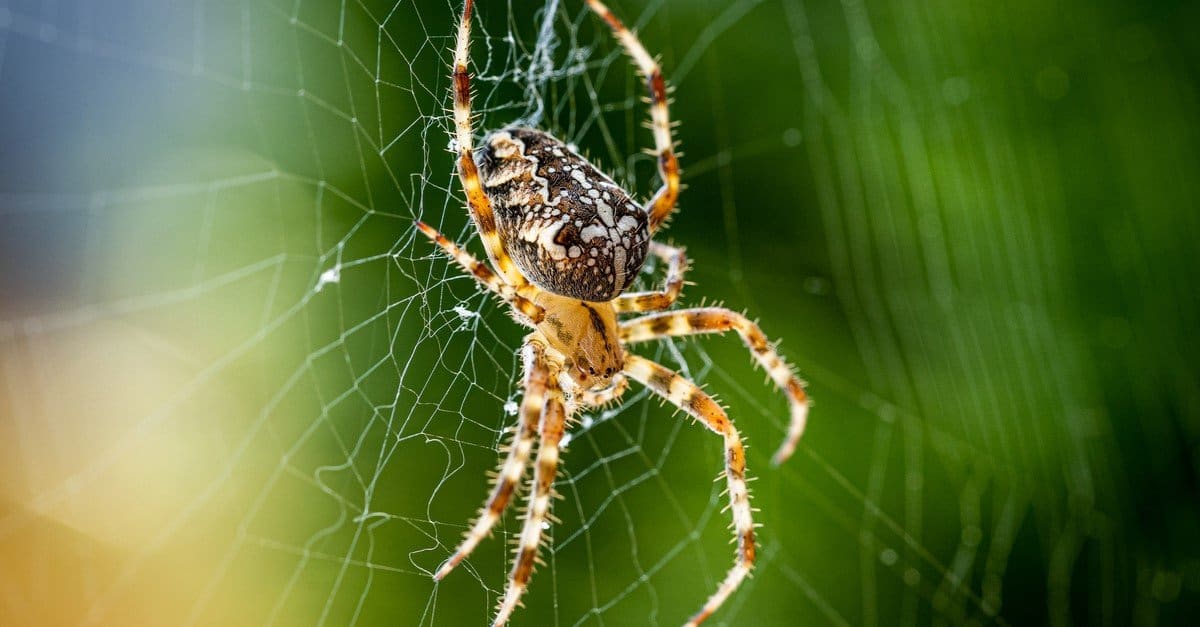
Orb Weavers (Araneus diadematus) are not harmful to humans and it’s not necessary to get rid of them.
©novama/Shutterstock.com
It is really unnecessary to get rid of Orb Weavers or engage in prevention, as they do not bite humans except in rare cases when cornered and they eat many bothersome insects. However, if you suffer from arachnophobia or they build a web across a walkway, the easiest prevention method to dissuade them from making their webs near your house is simply to use a long stick to remove the anchor strands of their webs. This should be done gently, so as not to agitate the spider overmuch. Breaking the web this way will let them know this is not a safe place to build their home and discourage them from building there again. They will typically drop off the web or just run away.
View all 66 animals that start with OOrb Weaver FAQs (Frequently Asked Questions)
Is an orb weaver spider poisonous?
Orb weavers are neither poisonous to eat, nor venomous to humans, whom they rarely bite.
Are orb spiders good to have around?
They are very beneficial, as they help rid gardens and yards of pests like mosquitoes.
How big can orb weavers get?
These spiders can be as large as 4 inches across.
Can you keep an orb weaver as a pet?
It would be difficult to keep an Orb Weaver as a pet, due to their need to create such large nests and their broad diet.
How long do orb weavers live?
Their life cycle lasts about 12 months.
Where do orb weavers go in winter?
Most orb weavers die in the winter after laying their last clutch of eggs.
Where do orb weaver spiders live?
Orb weavers’ habitat is in vegetation. They live in webs they spin between tree branches, shrubs and walls.
How do I get rid of orb weaver spiders?
They are beneficial spiders and it is recommended you leave them where they are whenever possible. However, if they are interfering with your day to day life, breaking the main strands of their web with a stick will tell them that area is not safe and encourage them to move on elsewhere.
What was the largest orb spider web ever found?
The largest spider web ever found was made by an orb spider called Darwin’s bark spider. It was a massive 82 foot web that spanned a river in Madagascar.
What are the differences between an orb weaver and a banana spider?
The most significant differences between an orb weaver and a banana spider include their size, coloration, and habitat.
Thank you for reading! Have some feedback for us? Contact the AZ Animals editorial team.
Sources
- Ehrlich, Available here: https://www.connorspest.com/pest-info/spiders/orbweaver-spider/
- North American Insects & Spiders, Available here: https://www.cirrusimage.com/orb-weaver-spiders/
- Bug Guide, Available here: https://bugguide.net/node/view/1972
- Ask! Wet & Forget, Available here: https://askwetandforget.com/where-do-spiders-go-in-the-winter/
- Wildlife Heritage Foundation, Available here: https://www.wildlifeheritage.org/orb-weaver-spider/
- Get Rid of All Things, Available here: https://www.getridofallthings.com/how-to-get-rid-of-orb-weaver-spiders-naturally/

